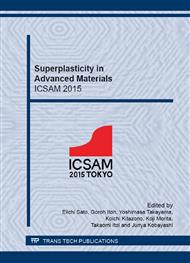p.308
p.314
p.320
p.326
p.332
p.338
p.344
p.350
p.355
Nanostructurization of Magnesium Alloy via Friction Stir Lap Processing
Abstract:
Friction stir processing (FSP) in a lap configuration of a metal sheet and an alloy plate has been examined to produce surface alloy layer with nanostructures. The 1-pass friction stir lap processing (FSLP) over 0.5 mm-thick Cu sheet on an AZ91 substrate produced multilayer structure with nanograins and/or nanoprecipitates in each layer, but the structure distributed only partially in the stir zone (SZ). Through the 3-pass FSLP along the same line, the multilayer structure has disappeared and the fine structure with precipitates in size ranging from several 100 nanometer to 3 micrometer has yielded among the entire SZ. 2-dimensional microhardness mapping have shown that the standard deviation of microhardness values in the SZ has decreased by half from 1-pass to 3 pass FSLP. Homogeneous microstructure involving nanostructures has been successfully produced via multi-pass FSLP.
Info:
Periodical:
Pages:
332-337
Citation:
Online since:
January 2016
Price:
Сopyright:
© 2016 Trans Tech Publications Ltd. All Rights Reserved
Share:
Citation:


